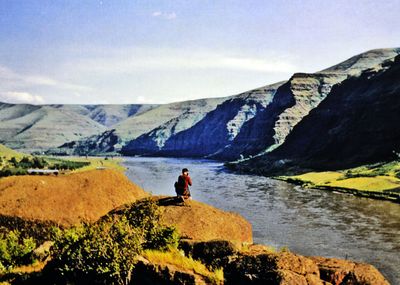Pre-dam photos may be glimpse of future
Salmon advocates want barriers removed

Anyone who’s driven U.S. Highway 12 across southeast Washington’s rolling terrain into Idaho will recognize at least some of the scenery in Kyle Laughlin’s photographs.
The Snake River flows through weathered basalt canyons, bronzed by the setting sun. Orchards flourish at the river’s edge. Anglers fish for salmon and steelhead, and kids frolic on sandy beaches.
The photos were shot before the four Lower Snake River dams were built in the 1960s and 1970s. While much of the landscape is familiar, the photos capture glimpses of the pre-dam river – before the orchards and beaches were flooded by rising reservoirs, and while salmon runs were still abundant.
Laughlin, who died in 1984, spent 50 years documenting the region through photographs. The Moscow, Idaho, photographer’s work is part of a slide show put together by conservation groups, which say the pictures offer a vision of what the Lower Snake could return to if the dams were removed to restore salmon runs.
“The river really speaks through these photos,” said Jerry White, Save Our Wild Salmon’s Snake River landscape coordinator. “They show the kind of potential that this river holds to be an asset for the region.”
For 20 years, scientists and politicians have debated breaching the dams to help restore salmon runs.
The debate was largely academic during the Bush years. During a 2003 campaign stop at Ice Harbor Dam, President George W. Bush said the dams would never be breached on his watch. Government agencies offered other solutions to bolster dwindling salmon runs, such as improving fish habitat and passage through the dams.
Now the federal salmon recovery plan is in court, challenged by environmental groups. During a hearing in early March, U.S. District Court Judge James Redden said he hasn’t ruled out the possibility of eliminating dams to restore the Snake River’s once-fabled salmon runs.
“I hope it’s never done, but that’s the last fallback,” the Associated Press quoted Redden as saying.
By publicizing the historic photos, Save Our Wild Salmon is encouraging people who live along the Lower Snake to ask “what if,” said Sam Mace, the group’s Inland Northwest project director.
“What if the dams came out?” she said.
How would grain that leaves Lewiston in barges get to Portland? How could better fish returns and a free-flowing river benefit tourism in Lewiston and Clarkston? How would electricity generated by the dams be replaced?
“We want a river that works for people as well as salmon,” Mace said. “The energy piece is critical. We can’t replace the dams with polluting energy.”
However Redden rules, Lower Snake dam removal would face a rocky political path, said Tom Karier, the Eastern Washington representative of the Northwest Power and Conservation Council, which hasn’t taken a stance on dam-breaching.
“My understanding is that ordering the dams’ removal is not something a federal judge could do,” he said. “Breaching the dams would require a significant amount of money, and that would require an act of Congress.”
Climate change has upped the ante in the dam debate, Karier added.
“The dams have an impact on salmon runs, but they also don’t emit any carbon,” he said. “That’s the core of the conflict.”
Together, the four dams generate about 1,000 megawatts of electricity – enough to power Seattle, but still a relatively small slice of the Northwest’s overall energy needs. In a 2006 report, the Northwest Energy Coalition’s Steve Weiss said the lost electricity could be replaced through conservation and wind power. The coalition advocates for renewable energy and conservation.
But the 2006 report was criticized for underestimating the cost of replacement power. In a new report issued last week, Weiss said gas-fired turbines would be needed to replace the dams’ “peaking ability” – the flexibility dam operators have to increase output during cold snaps or hot spells, when energy use peaks from furnaces and air conditioners.
The Northwest Power and Conservation Council did its own study, using models that replaced the dams’ output with electricity from gas-fired turbines and coal plants. The models showed a net annual increase in carbon emissions of 3.6 million tons by 2024.
“As a region, we’re working hard to expand our renewable and carbon-free energy,” Karier said. “This would set back our progress.”
Mace, of Save Our Wild Salmon, argues that climate change strengthens the case for dam-breaching. Warmer stream temperatures are expected to take a heavy toll on salmon populations by reducing the amount of habitat in which the temperature-sensitive fish can survive.
Breaching the dams would remove barriers to “the largest intact piece of salmon habitat in the Lower 48,” Mace said. “Some of these salmon species spawn at 6,500 feet. Those streams are going to stay colder longer.”
Dustin Ahern’s family has lived in the Lewiston area for four generations. He’s a whitewater rafting guide and construction worker who also runs Citizens for Progress, an economic development group.
If the dams came out, the region would have to be “made whole,” Ahern said. “There’s a fair amount of business that uses the reservoir system on the Lower Snake.”
At 35, Ahern is too young to remember prolific salmon runs, but his grandmother does. She grew up during the Great Depression. Whenever the cupboard was bare, her dad would go fishing.
“To this day, she’s not terribly fond of eating salmon. … It was a sign that you were very poor,” Ahern said.
“Now, with wild salmon running $15 to $20 per pound, it’s kind of come full circle.”